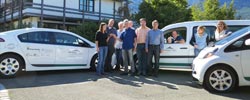Full speed ahead for electric vehicles

Dr. Sabine Wagner (left), head of Fraunhofer IAO’s Garmisch-Partenkirchen branch lab, presenting Prof. Hans Peter Schmid, head of the IMK-IFU, KIT, with the keys to the electric vehicles to be used in the test.<br><br>© IMK-IFU, KIT<br>
After bringing electromobility to its home community, Fraunhofer IAO’s branch lab in Garmisch-Partenkirchen is teaming up with the University of Stuttgart’s Institute for Human Factors and Technology Management IAT to do the same for a neighbor.
In September 2013, three electric vehicles joined the fleet serving the Institute of Meteorology and Climate Research – Atmospheric Environmental Research (IMK-IFU), part of the Karlsruhe Institute of Technology (KIT).
To discover the best ways of electrifying vehicle fleets, Fraunhofer IAO is collecting data from test fleets of electric vehicles in the “elektromobilisiert.de” project. Eight electric vehicles spent the last three months zooming around Garmisch-Partenkirchen as part of the community’s fleet. Now, the next test phase is up and running in collaboration with one of the largest and most innovative local employers: the Institute of Meteorology and Climate Research – Atmospheric Environmental Research (IMK-IFU) at the Karlsruhe Institute of Technology (KIT) – or KIT Campus Alpin for short.
KIT Campus Alpin management has decided to follow its home community’s good example, so from September 2013 until March 2014, e-mobility experts from Fraunhofer IAO and the IAT will be assessing the potential for electrifying the campus’s own vehicle fleet. Their efforts complement Garmisch-Partenkirchen’s e-GAP activities in its role as an electromobility model community.
At the beginning of October, Dr. Sabine Wagner, head of Fraunhofer IAO’s Garmisch-Partenkirchen branch lab, really got things moving by presenting Prof. Hans Peter Schmid, head of the IMK-IFU, KIT, with the keys to the electric vehicles to be used in the test. Prof. Schmid hopes that this test phase will pave the way for sustainable mobility management within his organization: “The test phase will also show us to what extent electric vehicles can help us in our work taking scientific measurements.”
He expects the fleet analysis to generate useful pointers on the future makeup of the campus’s vehicle pool. Dr. Peter Suppan, managing director of the IMK-IFU, KIT, is delighted at the chance to give his employees a real taste of e-mobility. He also sees the test phase as enhancing Garmisch-Partenkirchen’s role as an electromobility model community and as yet another step toward minimizing KIT Campus Alpin’s environmental impact.
“We are proud that, after serving Garmisch-Partenkirchen’s community fleet, the journey for our electric vehicles is able to continue at an innovative local company,” says Dr. Wagner. “This underscores the demand for such projects is a logical complement to local e-mobility model community activities.”
Going by the name “elektromobilisiert.de”, Fraunhofer IAO and the IAT at the University of Stuttgart are also offering other innovative public authorities, communities and companies the chance to have their fleets scientifically tested. Using software developed by Fraunhofer IAO, conventional fleets’ logbooks are evaluated to help determine the potential for making such fleets electric. This analysis takes into account such factors as range, charging times, costs and damage to the environment. And while these numbers are being crunched, researchers will also be analyzing the three-month practical trial they are carrying out using electric vehicles. More information about the “elektromobilisiert.de” project, which is being funded by Germany’s Federal Ministry of Transport, Building and Urban Development (BMVBS), is available (in German) at elektromobilisiert.de.
Media Contact
More Information:
http://www.iao.fraunhofer.deAll latest news from the category: Transportation and Logistics
This field deals with all spatial and time-related activities involved in bridging the gap between goods and people, including their restructuring. This begins with the supplier and follows each stage of the operational value chain to product delivery and concludes with product disposal and recycling.
innovations-report provides informative reports and articles on such topics as traffic telematics, toll collection, traffic management systems, route planning, high-speed rail (Transrapid), traffic infrastructures, air safety, transport technologies, transport logistics, production logistics and mobility.
Newest articles

Bringing bio-inspired robots to life
Nebraska researcher Eric Markvicka gets NSF CAREER Award to pursue manufacture of novel materials for soft robotics and stretchable electronics. Engineers are increasingly eager to develop robots that mimic the…

Bella moths use poison to attract mates
Scientists are closer to finding out how. Pyrrolizidine alkaloids are as bitter and toxic as they are hard to pronounce. They’re produced by several different types of plants and are…

AI tool creates ‘synthetic’ images of cells
…for enhanced microscopy analysis. Observing individual cells through microscopes can reveal a range of important cell biological phenomena that frequently play a role in human diseases, but the process of…





















